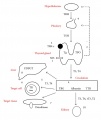File:Thyroid hormone homeostasis.jpg: Difference between revisions
No edit summary |
|||
| Line 27: | Line 27: | ||
Figure 1 JTR2011-342189.001.jpg http://www.ncbi.nlm.nih.gov/pmc/articles/PMC3170895/figure/fig1 | Figure 1 JTR2011-342189.001.jpg http://www.ncbi.nlm.nih.gov/pmc/articles/PMC3170895/figure/fig1 | ||
===Reference=== | ===Reference=== | ||
<pubmed>21918727<pubmed>| [http://www.ncbi.nlm.nih.gov/pmc/articles/PMC3170895 PMC3170895] | <pubmed>21918727</pubmed>| [http://www.ncbi.nlm.nih.gov/pmc/articles/PMC3170895 PMC3170895] | ||
Revision as of 00:14, 23 September 2011
Thyroid Hormone Homeostasis
The complex mechanisms of regulation of thyroid hormone homeostasis and the possible mechanism of action of the thyroid disrupting chemicals.
The thyroid and the thyroid hormones, tri-iodothyronine (T3) and thyroxine (T4), participate with the hypothalamus, secreting thyrotropin releasing hormone (TRH), and pituitary, secreting thyrotropin (TSH) in a classical feedback controlled loop.
Iodide is transported into the cell by the sodium-iodine symporter (NIS) and oxidized by thyroid peroxidase (TPO). TPO also catalyzes the iodination of thyrosine residues on thyroglobulin (Tg).
All processes in the cell are stimulated by binding of TSH to the TSH receptor (TSH-R).
- In the circulation, thyroid hormones are bound to thyroxine-binding globulin (TBG), albumin and prealbumin, and in some cases transthyretin (TTR). T4 is deiodinated by deiodinases in the liver and target tissues.
- In the target cells, T3 binds to nuclear thyroid hormone receptor (TR), and with the retinoid X receptor, it binds at specific sequences at the DNA string, forming the thyroid hormone response elements (TRE).
- In the liver, thyroid hormones are metabolized by UDP-glucuronyl transferase (UDPGT), and finally, the metabolites are excreted in the urine.
Possible mechanism of action of the thyroid disrupting chemicals
- Inhibition of iodine uptake in the cells by inhibition of NIS: perchlorate, thiocyanate, nitrate, and phthalates.
- TPO inhibition: NP and isoflavones.
- Inhibition of TSH-R: DDT and PCB.
- Binding to transport proteins: PCB, phthalates, phenol, flame retardants, and HCB.
- Cellular uptake of thyroid hormones: phthalates and chlordanes.
- Binding to thyroid hormone receptor and affecting gene expression: PCB, phenols, flame retardants, BPA and HCB.
- Inhibition of deiodinases: Styrenes and UV-filters,
- Activation of hepatic UDPGT: dioxins and pesticides,
- Inhibition of the hypothalamo-pituitary-thyroid axis: lead.
- Excretion/clearance of thyroid hormones: PCB, dioxin, phenols, flame retardants, HCB, and BPA.
Figure 1 JTR2011-342189.001.jpg http://www.ncbi.nlm.nih.gov/pmc/articles/PMC3170895/figure/fig1
Reference
<pubmed>21918727</pubmed>| PMC3170895
Copyright © 2011 Marie-Louise Hartoft-Nielsen et al.
This is an open access article distributed under the Creative Commons Attribution License, which permits unrestricted use, distribution, and reproduction in any medium, provided the original work is properly cited.
File history
Click on a date/time to view the file as it appeared at that time.
| Date/Time | Thumbnail | Dimensions | User | Comment | |
|---|---|---|---|---|---|
| current | 00:06, 23 September 2011 |  | 600 × 712 (80 KB) | S8600021 (talk | contribs) | ==Thyroid Hormone Homeostasis== The complex mechanisms of regulation of thyroid hormone homeostasis and the possible mechanism of action of the thyroid disrupting chemicals. The thyroid and the thyroid hormones, tri-iodothyronine (T3) and thyroxine (T4), |
You cannot overwrite this file.
File usage
The following 2 pages use this file: